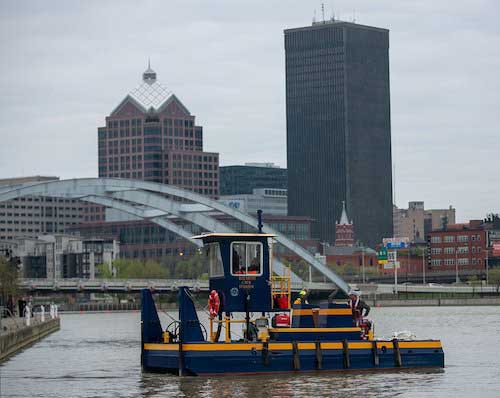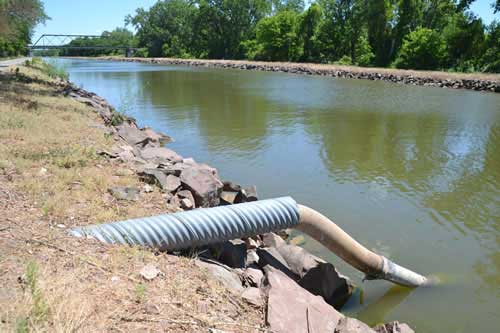Governor looking for best ideas to revitalize canal corridor
Press Release, Gov. Andrew Cuomo’s Office

Photo from Gov. Andrew Cuomo’s Office: A new tugboat was named after women’s rights pioneer Elizabeth Cady Stanton during an unveiling in Rochester on Friday, when the Erie Canal opened for its 195th season. The canal played a significant role in the women’s rights movement.
Governor Andrew M. Cuomo on Friday announced a sweeping initiative to examine how the 195-year-old Erie Canal can be reimagined for the 21st century in an effort to boost local economies, inspire new opportunities for tourism and recreation, and strengthen environmental resiliency along the historic waterway.
A key pillar of this initiative is the Governor’s Reimagine the Canal Task Force.
“The Erie Canal corridor is one of New York’s most iconic assets and remains a key economic driver for the region and the state,” Governor Cuomo said. “The Canal helped make New York the Empire State and this initiative will reimagine the canal and adapt it for new uses in upstate communities, furthering upstate New York’s unprecedented growth.”
“The New York Canal System is not only an iconic recreational destination, it is also an essential part of our economic past, present, and future,” said Lieutenant Governor Kathy Hochul, who made the announcement. “As we kick-off the 2019 Canal season, we launch the next phase of Reimagine the Canals with a task force to guide bold and innovative new ideas. In addition, we celebrate the Erie Canal’s role in shaping the flow of ideas throughout our history by dedicating a new vessel in honor of New York suffragette Elizabeth Cady Stanton. Her legacy as a leading voice and activist for voting rights inspires us today as we work to secure full equality for all women.”
The Governor’s groundbreaking initiative will:
• Identify potential new uses for the Erie Canal aimed at improving the quality of life for New Yorkers
• Evaluate how the Erie Canal can support and enhance economic development along the canal corridor
• Find new opportunities to enhance recreation and tourism along the Erie Canal
• Assess how the Erie Canal can help mitigate impacts from flooding and ice jams to improve resiliency and restore ecosystems in canal communities
• Identify opportunities for using Erie Canal infrastructure to expand irrigation for Western New York farms
To help meet those goals, Governor Cuomo has created a task force that is an outgrowth of the Reimagine the Canals Competition, held last year by the New York Power Authority and New York State Canal Corporation. The competition rewarded the best ideas to enable New York’s canals to serve as an engine of economic development or spark new forms of recreation. This task force will explore many of the ideas that the competition has already produced. The New York Power Authority operates the Canal Corporation as a subsidiary.
“There are 147 communities along the Erie Canal and we should do everything we can to help them become more resilient,” said Brian U. Stratton, Canal Corporation director. “Just as it transformed New York when it opened nearly 200 years ago, the Erie Canal can be transformed so it remains an essential piece of the fabric that defines upstate New York.”

File photo by Tom Rivers: The task force may look for ways for farmers to utilize canal water. This photo from June 2016 shows a siphon just west of the Keitel Road bridge in Albion. Area farmers struggled in drought conditions that year.
The task force will be chaired by Joanie Mahoney, New York State Thruway Authority chair and former Onondaga County Executive, who will also oversee outreach in Central New York. Former Lieutenant Governor Bob Duffy, will serve as regional co-chair in Western New York, while Joseph Martens, former Department of Environmental Conservation commissioner, will serve as co-chair in the Mohawk Valley. Other members will be announced in the coming weeks.
The panel is also expected to examine how canal infrastructure can be used to increase the reliability of the water supply to farms in Western New York—which now draw water from the Canal—and can enable additional land to be used for agriculture.
Helping guide the task force will be the Nelson A. Rockefeller Institute of Government, a part of the State University of New York. It will work to engage stakeholders and canal communities, a process that will include a series of public meetings across the state where residents, business owners and municipal leaders can provide input on the Canal’s future.
The reimagining initiative builds on successful efforts by Governor Cuomo to invest in the canal corridor, including the Downtown Revitalization Initiative and Taste NY, which have stoked new industries, businesses and housing in canal communities.
Harnessing the Canal’s full potential to attract more tourism and recreation is a key focus of the Initiative. There are 1.6 million trips taken annually on the Erie Canal Trailway, the former towpath used by mules and horses to pull barges in the canals’ early days. The Trailway is part of Governor Cuomo’s Empire State Trail, which at 750 miles will be the largest state multi-use trail network when completed in late 2020.
The navigation season on the Canal System, which includes the Erie, Cayuga-Seneca, Champlain and Oswego canals, runs today through October 16. About half of the system, including parts of the Erie Canal, along with the Champlain and Oswego canals, had their openings postponed due to high water flows stemming from heavy rains and snow melt.
For the third straight year, tolls have been waived for recreational vessels
Empire State Development President Howard Zemsky said, “Reactivating former industrial waterfronts has fueled economic growth throughout the Northeast and Mid-Atlantic and it’s only fitting that the Erie Canal-a game changer for the New York State economy when it opened—will further help to create jobs and opportunity in the communities along its banks.”
Agriculture Commissioner Richard A. Ball said, “The Erie Canal is an important water source to a number of farms along its western banks. This task force offers the opportunity to now look at expanding the use of the Canal to minimize the risk of drought on our farms and support the production of high-value crops, specifically fruits and vegetables.”





































































